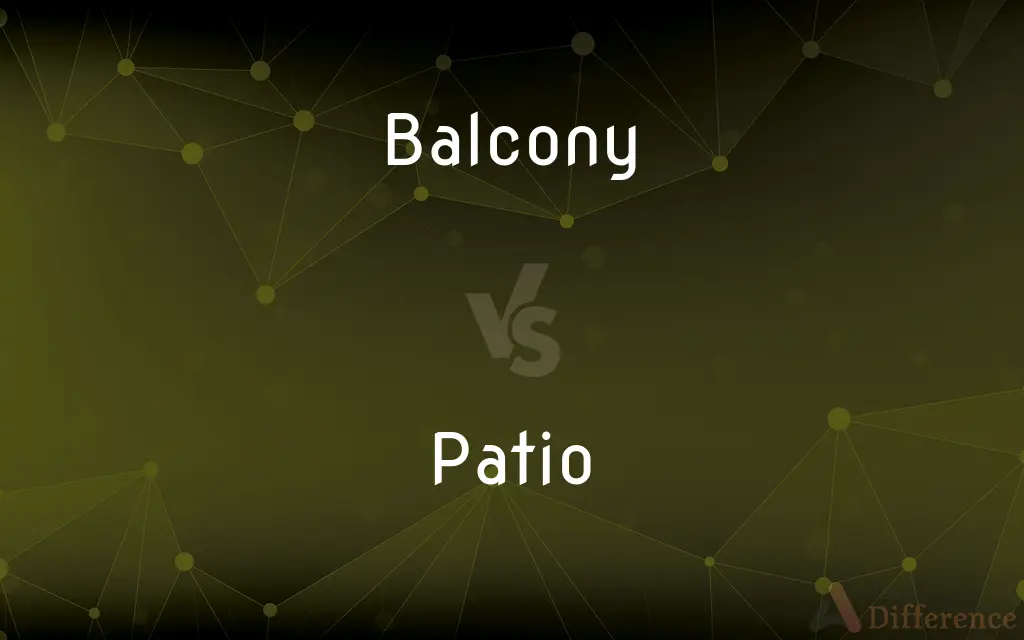Balcony vs. Patio — What's the Difference?
By Tayyaba Rehman — Updated on October 31, 2023
A balcony is an elevated platform extending from a building; a patio is a ground-level outdoor space usually adjacent to a home.

Difference Between Balcony and Patio
Table of Contents
ADVERTISEMENT
Key Differences
Balcony and Patio are two architectural terms describing outdoor spaces associated with buildings and homes. A balcony is typically an elevated platform that protrudes from the wall of a building. It's often accessed from an upper floor window or door and is usually enclosed by railings, balustrades, or parapets. In contrast, a patio is an outdoor space at ground level, often paved and adjoining a house, used for dining or recreation.
Most urban apartment buildings feature balconies as they offer a small outdoor space for residents without the need for a backyard. These elevated platforms provide an excellent vantage point to enjoy city views or fresh air. On the other hand, patios are common in single-family homes, especially those in suburban areas. They allow homeowners to have a dedicated outdoor area right outside their back or side door, offering ease of access and the pleasure of an extended living space.
In terms of construction, balconies usually require more detailed architectural planning due to their elevation and the need for safety railings. They often have a limited weight-bearing capacity. Patios, being on the ground, don't come with such restrictions. They can be constructed using various materials, including concrete, stone, brick, or tiles, and can be adorned with outdoor furniture, plants, and other decorative items.
Weather considerations can also play a role in how each is utilized. Balconies, being elevated, might offer less protection from the elements and might be less usable during extreme weather conditions. Patios, given their ground-level positioning, can be equipped with pergolas, awnings, or umbrellas to offer shade and protection, enhancing their usability across different weather conditions.
Lastly, the choice between a balcony and a patio often comes down to personal preference and architectural possibilities. While balconies are a way to bring the outside in for those living in apartments or buildings, patios provide homeowners with a comfortable ground-level space to entertain, relax, or even garden.
ADVERTISEMENT
Comparison Chart
Positioning
Elevated platform protruding from a building.
Ground-level outdoor space.
Common In
Apartment buildings, especially in urban areas.
Single-family homes, especially in suburban areas.
Construction
Requires safety railings due to elevation.
Typically paved, without the need for railings.
Protection
Offers limited protection from the elements.
Can be equipped with pergolas, awnings, etc.
Primary Use
Viewing, small outdoor space for city dwellers.
Dining, recreation, entertainment, gardening.
Compare with Definitions
Balcony
A platform enclosed by a parapet or railing.
They sipped their morning coffee on the small balcony.
Patio
A courtyard or inner area open to the sky.
The apartment complex featured a central patio.
Balcony
A gallery in a theater or auditorium.
Our seats were in the balcony section of the theater.
Patio
A ground-level outdoor space usually adjacent to a home.
They hosted a barbecue on their patio last weekend.
Balcony
An elevated platform extending from a building.
She stood on the balcony to get a better view of the parade.
Patio
An outdoor extension of a home's living space.
The sliding doors led to a spacious patio.
Balcony
An outdoor space accessed from an upper floor.
The hotel room featured a balcony overlooking the sea.
Patio
An area typically paved, used for dining or recreation.
The sunlit patio was adorned with plants and furniture.
Balcony
A balcony (from Italian: balcone, "scaffold") is a platform projecting from the wall of a building, supported by columns or console brackets, and enclosed with a balustrade, usually above the ground floor.
Patio
A Spanish term meaning "courtyard" or "back garden."
The villa had a beautiful patio with a fountain.
Balcony
A platform that projects from the wall of a building and is surrounded by a railing, balustrade, or parapet.
Patio
A patio (, from Spanish: patio [ˈpatjo]; "courtyard", "forecourt", "yard") is an outdoor space generally used for dining or recreation that adjoins a residence and is typically paved. In Australia the term is expanded to include roofed structures such as a veranda, which provides protection from sun and rain.
Balcony
A gallery that projects over the main floor in a theater or auditorium.
Patio
An outdoor space for dining or recreation that adjoins a residence and is often paved.
Balcony
(architectural element) An accessible structure extending from a building, especially outside a window.
Patio
A roofless inner courtyard, typically found in Spanish and Spanish-style dwellings.
Balcony
An accessible structure overlooking a stage or the like.
Patio
A paved outside area, adjoining a house, used for dining or recreation.
Balcony
A platform projecting from the wall of a building, usually resting on brackets or consoles, and inclosed by a parapet; as, a balcony in front of a window. Also, a projecting gallery in places of amusement; as, the balcony in a theater.
Patio
An inner courtyard typical of traditional houses in some regions of Spain.
The flat looks out on a patio on one side and a churro café on on the other.
Balcony
A projecting gallery once common at the stern of large ships.
Patio
A paved yard or floor where ores are cleaned and sorted, or where ore, salt, mercury, etc., are trampled by horses, to effect intermixture and amalgamation.
Balcony
An upper floor projecting from the rear over the main floor in an auditorium
Patio
In Spain, Spanish America, etc., a court or courtyard of a house or other building; esp., an inner court open to the sky.
Balcony
A platform projecting from the wall of a building and surrounded by a balustrade or railing or parapet
Patio
A usually paved area adjacent to a dwelling, used for outdoor lounging, dining, receptions of guests, etc.
Balcony
An ornamental feature on a building's facade.
The historic building had intricately designed balconies.
Patio
Usually paved outdoor area adjoining a residence
Common Curiosities
Are patios exclusive to single-family homes?
No, but they're more common in such settings compared to apartment complexes.
What's the main difference between a balcony and a patio?
A balcony is elevated, while a patio is at ground level.
Is a balcony considered an outdoor space?
Yes, it's an outdoor platform accessed from an upper floor.
Can patios be covered for protection from the elements?
Yes, patios can have pergolas, awnings, or umbrellas for shade and protection.
Do balconies always protrude from buildings?
Typically, yes; they extend from a building and are enclosed by railings.
Do balconies offer good views?
Being elevated, balconies often provide a vantage point, offering views of the surroundings.
Are balconies common in apartment buildings?
Yes, especially in urban areas, offering residents outdoor space.
Do patios enhance a home's living space?
Yes, they extend the living space outdoors and can be used for various activities.
Can both balconies and patios increase property value?
Yes, both can enhance property value by offering outdoor spaces for relaxation and entertainment.
Is safety a concern for balconies?
Yes, due to their elevation, they require safety railings.
Can patios be made of different materials?
Yes, patios can be constructed from concrete, stone, brick, or tiles.
Can patios be used for gardening?
Yes, many people use their patios for gardening, among other activities.
Are there weight restrictions for balconies?
Often, yes. Due to structural concerns, balconies may have weight limits.
Can a balcony be in the interior of a building, like in an atrium?
Yes, some balconies overlook interior spaces like atriums or galleries.
Is the term "patio" of Spanish origin?
Yes, "patio" is Spanish for "courtyard" or "back garden."
Share Your Discovery

Previous Comparison
Band vs. Strip
Next Comparison
Communism vs. AnarchismAuthor Spotlight
Written by
Tayyaba RehmanTayyaba Rehman is a distinguished writer, currently serving as a primary contributor to askdifference.com. As a researcher in semantics and etymology, Tayyaba's passion for the complexity of languages and their distinctions has found a perfect home on the platform. Tayyaba delves into the intricacies of language, distinguishing between commonly confused words and phrases, thereby providing clarity for readers worldwide.
















































